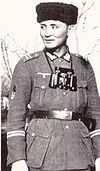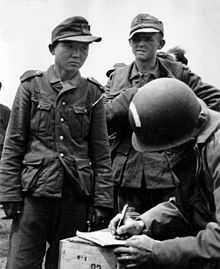Ostlegionen
Ostlegionen (literally "Eastern Legions") or Osttruppen ("Eastern Troops") were conscripts and volunteers from the occupied eastern territories recruited into the German Army of the Third Reich during the Second World War.
The staff of the disbanded German 162nd Infantry Division in occupied Poland (the Generalgouvernement, was charged with the raising and training of the six Eastern Legions. It eventually raised and trained 82 battalions. A total of 98 battalions were raised with 80 serving on the Eastern Front and in the Balkans. 12 were later transferred to France and Italy in 1943.
Strength

| Legion | Size and composition |
|---|---|
| Armenian Legion | 11 Armenian battalions |
| Azerbaijani Legion | 14 Azeri battalions |
| Caucasian Muslim Legion | 5 North Caucasus battalions, which consisted of Azeris, Chechens etc. |
| Georgian Legion | 14 Georgian battalions |
| Turkestan Legion | 34 Turkestani battalions, composed of Turkomans, Uzbeks, Kazakhs etc. |
| Volga-Tatar Legion | 8 Volga-Tatar battalions |
Ostbataillone

The East Battalions were battalion-size units that wore German uniforms and equipment and were integrated into larger German formations. They began as the private initiatives of individual military commanders, but eventually became formalized and by late 1943 they contained 427,000 volunteers and conscripts, a force equivalent to 30 German divisions. Many were utilized in the east, e.g. Yugoslavia.
The battalions of the Turkistani Legion formed part of the 162nd Infantry Division and saw much action in Yugoslavia and Italy.
A number of Osttruppen battalions were used to guard parts of the Normandy region prior to Operation Overlord, specifically Utah, Juno and Sword beaches. Ost units that fought in the Battle of Normandy were from the 243rd and 709th Static Infantry Divisions. Numerous Ost units were also present on the German side during the Allied landing in Southern France, codenamed Operation Dragoon.
At least one Ost battalion was still active in September 1944 during the fighting north of Antwerp.
Legacy
The majority of Ost soldiers were recruited from the Soviet Union and other occupied nations of Eastern and Northern Europe. Ost troops frequently provided valuable anti-partisan duties, freeing up regular German forces for front line service. The effectiveness of the Ost units varied, with some fighting with considerable courage while others simply surrendered once attacked by enemy forces. In general, Ost troops were stationed away from critical areas and used for rear-guard duties whenever possible.
See also
| Wikimedia Commons has media related to Ostlegionen. |
References
Further reading
- The East Came West: Muslim, Hindu, And Buddhist Volunteers in the German Armed Forces, 1941-1945, edited by Antonio J. Munoz (Axis Europa Books, 2002, ISBN 1-891227-39-4).
External links
- Historical lessons for the British and Germans The case for integrated indigenous forces as a logical force multiplier
- Collection of film footage and photos of Ostlegionen on YouTube
- Korean volunteers